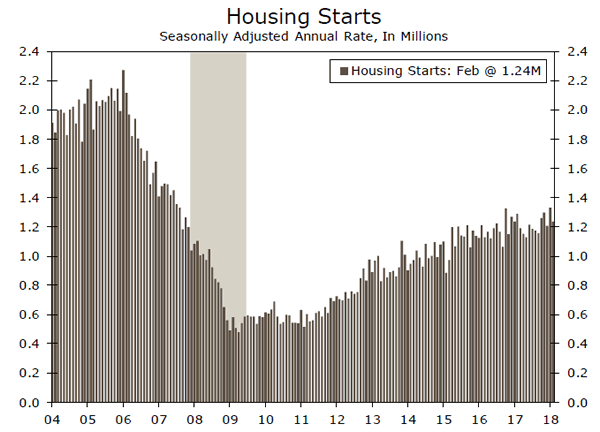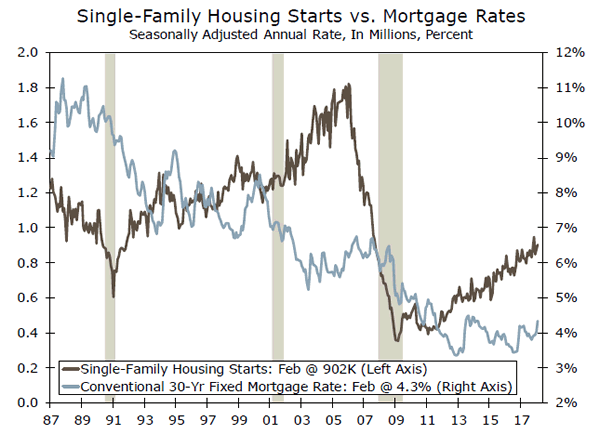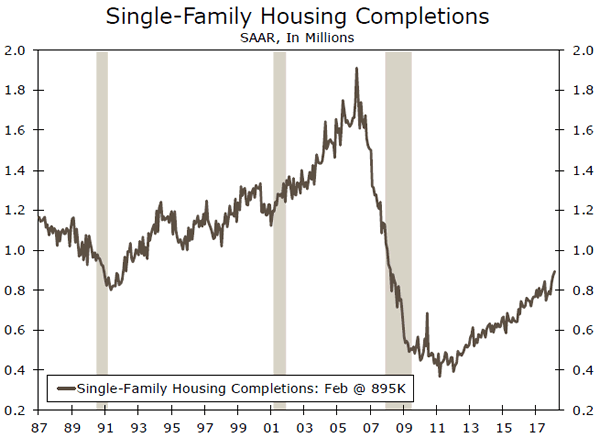Housing starts fell 7.0 percent in February to a 1.236-million unit pace. All the drop was in the volatile multifamily sector, plunging 26.1 percent. Single-family starts rose 2.9 percent and continue to trend higher.
Improving Trend Beneath the Headlines
Despite the 7 percent drop in overall housing starts, new home construction continues to gradually build momentum. All of February’s drop was in multifamily starts, which are notoriously volatile and are primarily driven by apartment construction. Multifamily starts tumbled 26.1 percent in February, following a 25.6 percent gain the prior month. Apartment construction has been unusually volatile the past few months. Deliveries have increased significantly, which has pushed vacancy rates modestly higher and caused rents to ease up a bit. Demand for apartments remains strong, however, and apartment development is picking up in many secondary and tertiary markets that had not seen much development during the earlier boom.
Single-family starts rose 2.9 percent in February, following a 3.5 percent rise in January. The winter months are normally a slow period for new home construction, but unseasonably mild winter weather and the lack of new homes available for sale have allowed for more construction to get underway, particularly in the supply starved West and South. Through the first two months of this year, single-family starts are running 7.8 percent ahead of their year ago pace. Starts in the West through February are up 30.8 percent, with much of the gain likely coming from California, Arizona and Nevada. Single-family starts are up 7.4 percent in the South through February but are down 1.6 percent in the Northeast and a whopping 26.2 percent in the Midwest, where the weather has been more typical of past winters.
The South and West account for the overwhelming majority of single-family housing starts. The two regions captured 77 percent of the nation’s singlefamily starts in 2017 and accounted for a like-sized share of completions. Job growth remains exceptionally strong in both regions, which continues to fuel a steady stream of in-migration. Affordability is becoming a challenge for many parts of the region, particularly in West. Rising home prices have set off an affordability migration back toward California’s interior. The Inland Empire is one of the biggest beneficiaries, and starts are up solidly over the past year. Inflows of retirees to Florida, Arizona and Nevada have also increased, as more boomers reach retirement age and tax reform prompts more people to move forward with plans to relocate.
The sluggish pace of the housing recovery has been noted repeatedly over the past few years. New home construction has been held back by shortages of buildable lots and skilled construction workers. Higher building material prices in the wake of the resumption of tariffs on imports of Canadian softwood lumber and rising prices for petroleum-based products have also made it harder to build entry-level homes. The tide appears to be turning somewhat, with completions of single-family homes trending higher over the past year. Profits margins are still being crimped, however, and affordability is being constrained further by higher mortgage rates.















